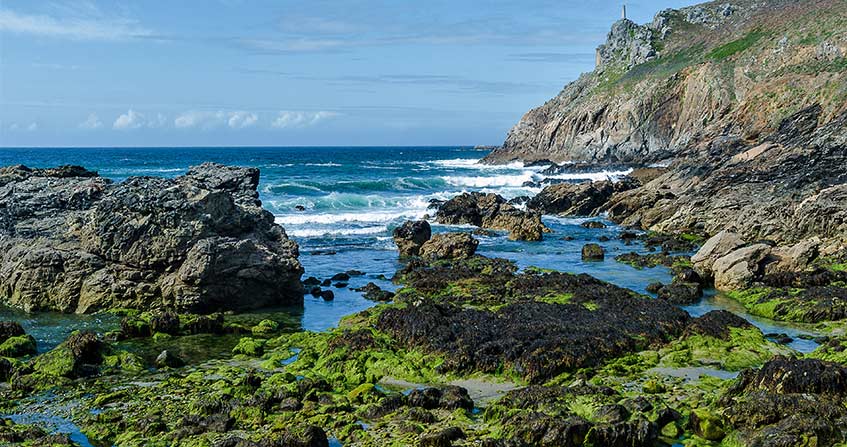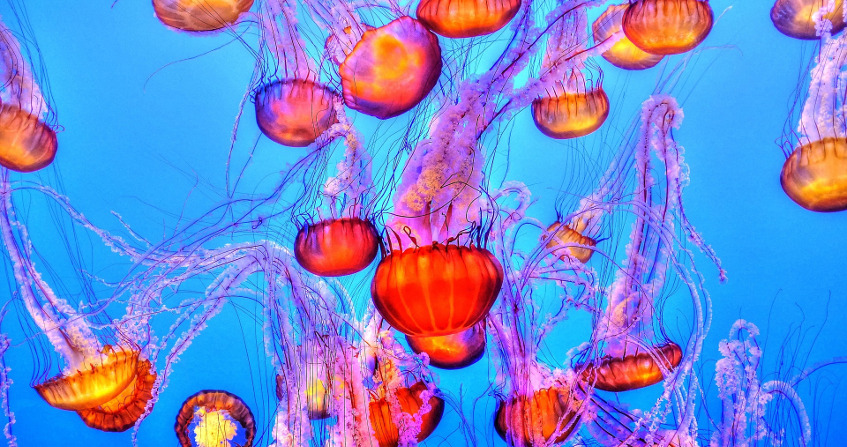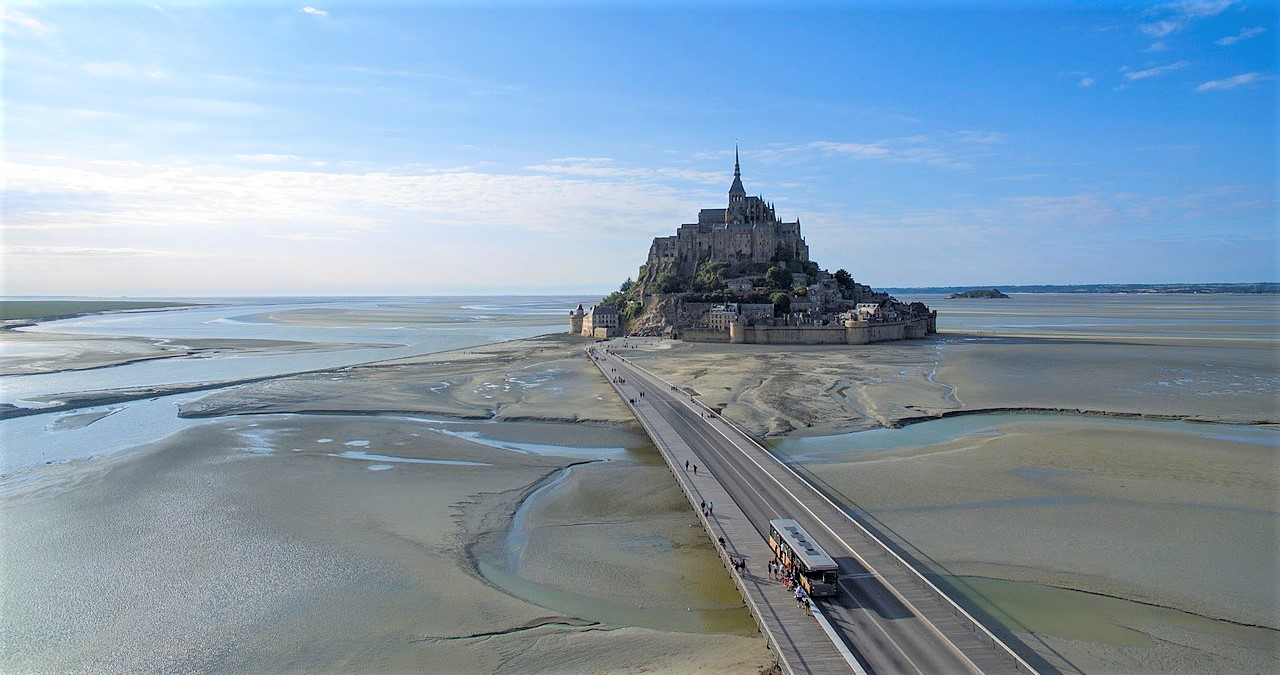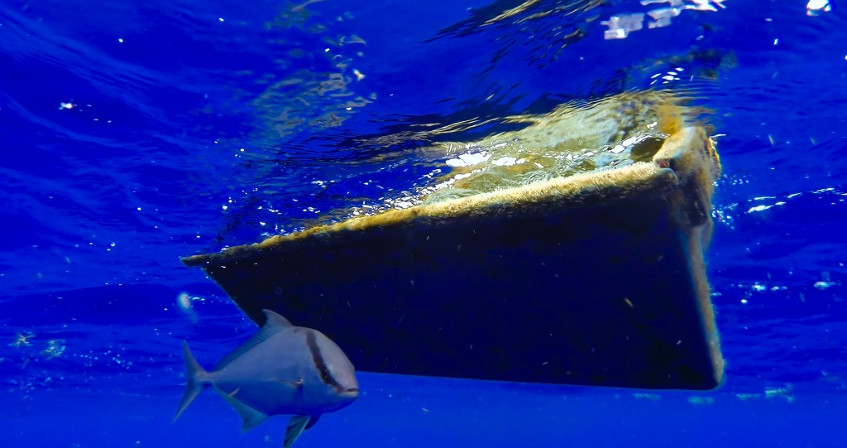Biodiversity on rocky coasts: zoning and ecological relationships
PDF
The Atlantic rocky coasts, subject to tidal sway, make it easy to observe the organisms that colonize them. Depending on the level and living conditions, various lichens or large brown algae dominate and form horizontal belts. Less clearly, some fixed or slightly mobile animals are also arranged in belts. Other animals and algae are distributed more irregularly through basins, channels and rocky overhangs. The specific diversity decreases upwards in the emerged area and also when conditions become too difficult: too turbulent, too sunny or with very variable salinity. Organisms on rocky coasts thus have many biological adaptations to emergence or agitation and many specializations and interrelationships related to nutrition.
The Atlantic coasts are subject to the tidal phenomenon; part of the coastline is thus exposed over a variable area that depends on the slope and tidal range. Organisms living in this tidal balancing zone and in the surrounding areas therefore have to withstand a very particular and quite variable environment over time. Depending on the characteristics of the mineral substrate, the coastlines are very different in appearance and correspond to distinct ecosystems.
Thus, on rocky coasts, the subject of this article, algae, especially brown algae (see focus Algae and their classification), and lichens fixed on the rock most often dominate and are distributed in horizontal belts, from the terrestrial environment to the marine environment always immersed; this is why we will insist on these structural species very easy to observe. Some fixed or slightly mobile animals also have such a vertical zoning, while more mobile species (fish, shrimps, various molluscs) follow the movements of the sea or take refuge in basins or sheltered blocks to survive.

On sandy or muddy coasts, the zonation is much less clear-cut, as the animals live mainly buried there, especially at low tide [1]. There are fewer plants, apart from local flowering rooted plants: Spartina, Salicornia or other flowering plants in calm high levels and eelgrass (Figure 1) in very low levels. Algae are practically absent due to a lack of stable fixation; the fauna of these environments is very different from that of rocks. An entire article would be needed on these ecosystems, which are organized and function very differently from those of rocky coasts.
1. Ecological factors and their effects
Many ecological factors, and the resulting physico-chemical gradients, directly affect the distribution of living organisms in marine coastlines, and these factors are most often correlated with each other, sometimes complicating interpretation.
1.1. Duration of emergence and dehydration

This factor is essential on the so-called tidal coasts of the Atlantic and the English Channel (and very secondary in the Mediterranean) (see The tides). Twice in about 24 hours, the intertidial zone is alternately submerged at high tide and emerged at low tide (Figure 2). This causes strong constraints on flora and fauna, mainly of marine origin. Moreover, according to the lunar and seasonal cycles, the amplitude of tidal sway varies greatly: important towards the full moon or the new moon and towards the equinoxes, it is quite low in the first and last quarters of the moon and towards the solstices [1] (see Light cycles and living organisms).
Thus, organisms living in the highest levels of the coastline have been selected to resist a long emergence from the marine environment at least 80% of the time. During emergence, they are exposed to direct sunlight, temperature variations, osmotic stress related to fresh rainwater or desiccation. In addition, in the air, marine wildlife can no longer absorb dissolved oxygen from the water; this implies that animals can keep some water around them or, more rarely, change the way they breathe [1]. These conditions are more stable and less constraining for species at the bottom of the foreshore; they are often the same species as those in the permanently submerged area [1].
The tidal range, or maximum difference in level between the lowest and highest seas, is typical of a given place and depends on the conformation of the coasts: 14 m in the bay of Mont Saint Michel, 8.50 m in Roscoff, about 6 m in Le Havre and Nantes, just over 4 m in Biarritz. The larger the tidal range, the wider and more diversified tidal swing areas and the wider the belts, thus understanding the interest of the French coasts of the Western Channel, from Cherbourg to Brest.

We therefore define four levels on our marine coasts [1],[2], depending on the marine influence and the duration of emergence (Figures 3 & 7):
- the adlittoral level in direct continuity with terrestrial ecosystems and subject to salt spray;
- the supralittoral level, which is only submerged during very high tides and storms;
- the midlittoral floor constantly swept by the tides and subdivided into three levels;
- the infralittoral level, the upper level of which only emerged during high tides and for less than an hour at a time. The latter extends up to 10 to 30 m under the sea, depending on the illumination of the sea bed.
The further down the rocky foreshore you go, the larger and more diversified the algae are and the more species there are in the fauna as well; it is for this reason that fishermen on foot wait for the high low tides to hunt or collect lobsters, seeweeds, periwinkles and abalones. Biomass and productivity are also highest in the infralittoral region.
1.2. Water agitation
This factor, linked to currents and waves, depends strongly on the orientation and conformation of the coasts: strong agitation on rocky capes exposed to the west or at the foot of cliffs and little agitation at the bottom of sheltered bays and estuaries. This has a great influence on organisms. Indeed, certain species of algae, in thalleDescribes the relatively simple vegetative apparatus of primitive plants (algae, lichens, certain bryophytes…) compared to that of evolved plants that have a cormus with stem, roots and leaves. too fragile or very long, are shredded or torn off by strong waves and some animals, poorly fixed or with too soft a body, cannot survive in beaten environments, while others need highly oxygenated beaten water to survive. It should be noted that the same coastal site can be very beaten in the upper mid-coast (by the high tide swell which arrives without obstacles) and relatively calm in the lower mid-coast or the infralittoral (where the waves are slowed down by various obstacles at low tide).

Depending on the effects observed on organisms (species present, size and biomass), three modes of agitation can be identified, with intermediates: “very beaten”, “moderately beaten” and “calm” (Figure 4). We see that the more the midlittoral is beaten, the less algal biomass there is and this can go as far as the bare rock without any organisms.
1.3. Illumination

Algae and lichens need light for photosynthesisBioenergetic process that allows plants, algae and some bacteria to synthesize organic matter from the CO2 in the atmosphere using sunlight. Solar energy is used to oxidize water and reduce carbon dioxide in order to synthesize organic substances (carbohydrates). The oxidation of water leads to the formation of O2 oxygen found in the atmosphere. Photosynthesis is at the base of autotrophy, it is the result of the integrated functioning of the chloroplast within the cell and the organism., but too much light is often harmful to organisms used to be protected by a sometimes cloudy water layer. At the mid-coastal level, some species therefore take refuge, to protect themselves from light, under other larger algae – the case of the red alga Catenella cespitosa of the upper mid-coastal – at the base of the rocks, which are always wet (Figure 4B) or under rocky overhangs. Many green algae tolerate high levels of light (see Figure 17A below), as well as brown algae at higher levels. Direct sunlight can also be a problem for many animals, such as sponges and ascidians (Figure 5), as it is accompanied by dehydration and heating.
1.4. Other physicochemical factors
With regard to the nature of the support, most large algae live on rocks or pebbles, fixed by holdfasts (see below Figure 14B) or false roots, and die fairly quickly if they detach themselves from them. The rocky coasts are therefore their favourite biotope. Granite, gneiss and coarse sandstone, with a rough surface, are the most favourable, while smooth sandstone or marly limestone and chalk, easily broken up by the sea, are less favourable. Some small species of algae are attached to other algae. Many animals survive only by being fixed on various solid supports (Figures 5 & 6 and see below, Figure 19): many gastropods, mussels, barnacles, sea anemones, sponges, ascidians…
During the flood, wide temperature variations and freezing are harmful to most marine organisms, which can only live at the bottom of the foreshore. Moreover, the flora and fauna are not identical between Biarritz and Dunkirk, as some species prefer fresh water; this is the case of large brown algae.
In estuaries, water salinity is lower and above all much more variable, eliminating many marine species. The water is also turbid, as it is loaded with mud, and many algae no longer have enough light in the low levels. Global biodiversity is therefore decreasing sharply, even if productivity remains very high.
1.5. Interspecific competition

Figure 6B illustrates another case of competition in the middle-coastal region: the strong agitation of the environment excluded here seeweeds, which allows the installation of the short cushions of the small Lichina who needs light; the barnacle larvae then settle only in areas without lichen; finally, as there are many barnacles fixed, there is little space left for the pads to scrape the rock !
2. Lichen or brown seaweed belts
By combining altitudinal zonation in stages and the various modes of water agitation, we can develop the table below (Figure 7) which presents the various plant belts of our rocky coasts [2],[4].

2.1. Lichens at upper littoral stages
Lichens are originally terrestrial organisms. This is why, unlike algae and marine animals, their specific diversity decreases as they descend towards the sea. Many species of lichens can be found on coastal rocks, some of which also live inland (Xanthoria parietina) and others are typical of the marine coastline (Verrucaria maura, Lichina spp.) [3].

Lichen belts can be seen from afar due to their high contrasted colours (Figure 8). Above, in the adlittoral layer, where there are also a few flowering plants that support the salt of the sea spray, the light green tufts of the Ramalina, the orange-yellow foliage thallus of the Xanthoria and the various crust thallus, ranging from white to dark grey or brown, of many genera of lichens (Figure 9A) are most notable.

The supra-coastal layer, covered at very high tides, is colonized by the crusts of Caloplaca marina and C. maritima scattered in an almost continuous black belt of Hydropunctaria (= Verrucaria) maura (Figure 9B). This last fine-crusted lichen is often mistaken for a remnant of oil spills! Among the rare lichens in the mid-coastal zone are Lichina pygmaea, which live in very beaten environments (Figure 6).
On very rough coasts, the adlittoral and supralittoral levels extend upwards (more than 20 m on the cliffs of Finistère, Quiberon or La Hague) with very wide lichen belts; the very harsh conditions of these coasts favour lichens, whose symbiosis of filamentous fungus, green algae or cyanobacteria makes them more resistant compared to flowering plants. On the other hand, in wave-sheltered estuaries, all these belts together only reach a height of 20 cm; calm conditions even allow oaks to approach the sea and soak their branches at high tide.
2.2. Brown algae of medium and low levels

Brown algae or Phaeophycea, Fucales and Laminariales, largely dominate rocky foreshores by their biomass [2]. They were once used to extract soda by burning it in ovens or to fatten fields, under the name of varech in Normandy and goëmon in Brittany [5] i.e. wrach or kelp in english. They therefore form the characteristic belts of the mid- and sub-littoral levels. Their size, as well as their biomass, increases as they descend: 10 cm for Pelvetia, about 1 m for Ascophyllum and Sargassum and up to 5 m for Himanthalia and Laminaria hyperborea. The floats of some algae allow them to stand vertically at high tide, towards the light, in the case of Ascophyllum and Fucus vesiculosus.

The upper midlittoral (about 70-80% of the time emerging) consists of two algae belts that can withstand desiccation very well and can lose up to 75% of their water without dying; these are Pelvetia canaliculata (Figure 10A) and Fucus spiralis (Figure 10B); these algae are absent in very rough environments (Figure 6).

The average midlittoral (about 50% of the time emerging) is characterized by Ascophyllum nodosum and Fucus vesiculosus. The first (Figure 11) is very abundant in calm mode where it forms thick mats and is often parasitized by a red alga, Vertebrata lanosa. Fucus vesiculosus (Figure 12A) dominates in more beaten environments, but is missing in heavily beaten areas or has a special form of accommodation that is narrower, tougher and without floats (Figure 12B).

Finally, most of the lower midlittoral (about 30 to 20% of the time emerging) is colonized by Fucus serratus, still without floats (Figure 13).
The base of the lower midlittoral and the upper infralittoral (less than 10% of the time emerging) host the large thalli of Saccharina latissima (= Laminaria saccharina) (Figure 14A) in a calm environment, from Saccorhiza polyschides (Figure 14B) with flattened and soft stipeStream of algae, which lacks conductive vessels., edible Himanthalia elongata (Figure 15) or sea bean, with very long narrow and dichotomousTwo-part branching pattern at each growth level. More generally, characterizes the division of something into two clearly opposed elements axes, and Laminaria digitata (Figure 15) with a smooth and flexible cylindrical stipe, in more or less beaten environments.


The last belt, in the infralittoral never or very rarely emerged, consists of Laminaria hyperborea, with a stiff cylindrical stipe. The biomass of these algae is sometimes very high and is said to form “underwater forests”. Between Roscoff, Ouessant and Le Conquet, this species forms, with other kelps, the largest and richest algae sector in Europe (the Seaweed Coast), where a semi-industrial exploitation takes place for alginate extraction, among others.
3. Distribution of other organisms
3.1. Red and green algae
Other algae do not form real belts, continuous or regular [2].

Green algae, or Chlorophyceae, are mostly opportunistic and grow rapidly where there is little competition; they often withstand strong sunlight, variations in salinity or temperature and also the abundance of man-made nitrates. Among them, Ulva spp. (Figure16A) or sea lettuce proliferate during the summer on some rocks and then detach from them and accumulate in calm bays where they rot and producing foul smelling decomposing green tides (see Nitrates in the Environment).
On the other hand, red algae, or Rhodophyceae, do not tolerate too much light or significant desalination; from dark red to almost black sometimes in winter, they turn green during the summer, because the red pigments are destroyed by UV rays. For this reason, the number of red algae species decreases very rapidly upwards, from the middle mid-coastal. However, from the lower mid-coastal down, they form most of the specific diversity (more than half of the more than 500 macroalgae species in the Roscoff region, [6]). As they descend into the ever-submerged infralittoral, these algae benefit from their red pigment, phycoerythrin, which captures the last wavelengths of light transmitted by seawater [7].
The morphological, biological and ecological diversity of Rhodophyceae is very high, but they very rarely exceed 30 cm in length – Palmaria palmata (Figure 14B) -, while producing average to low biomass. On the boulders of the Fucus serratus belt, large, spots of similarly shaped Chondrus crispus (Figure 16B) and Mastocarpus stellatus can be observed; these algae, called liken or pioka in Breton, are harvested by hand to extract carrageenans, important industrial and food gelling agents.
In the medium to lower middle coast, very beaten and without brown algae, we can observe, only during the summer and in a dispersed way, the small blue-green skins of a cyanobacterium called Rivularia bullata or the soft, reddish and slightly branched axes of Nemalion helminthoides, a red alga.
3.2. Non-zoning rocky basins

The rocky basins, always filled with water, disturb the belt zoning of the foreshore; they offer a favourable biotope for various species that do not tolerate dehydration due to the exposure [1],[2]. Their level on the foreshore, their size, their depth and their illumination will condition their stands. The high level basins, which are desalinated, heated or lose their oxygen quickly, are poor in species, with mostly green algae (Figure 17A). Those below mid-tide level support a variety of animals: sea anemones, shrimps, gastropods, small fish, as well as various algae that normally live below and outside the basins. Figure 17B shows the brown alga Bifurcaria bifurcata (15 cm long) and various crustose calcified red algae of the Corallinaceae family; the latter do not leave the bottom of the basin and thus avoid dehydration.
3.3. Stacking and adaptations of fixed or slightly mobile fauna [1]
The gastropods of the Littorinidae group are spread as follows (Figure 18): Melaraphe neritoides in the supralittoral, Littorina nigrolineata and L. rudis in the upper midlittoral and Littorina littoralis and L. littorea (or winkle) from the middle midlittoral to the upper infralittoral; the first one, rarely submerged, has a respiratory and excretory physiology close to land snails. The various limbs and gibbles, other gastropods, are also staggered. In addition, Nucella lapillus, or dog whelk, has a thicker shell in beaten mode than in quiet mode.

In the crustacean group, barnacles are attached to the rock and protected by solid limestone plates; they also form more or less regular belts: Elminius modestus and Chthamalus stellatus (Figure 6) at the top, Balanus balanoides in the middle and Balanus perforatus and B. crenatus at the lowest levels.
To avoid being swept away by waves, animals are permanently glued to the rock or algae (Figures 5, 6 and 19), more or less temporarily fixed by filaments for mussels and a suction foot for limbs or stuck in cracks in difficult times (Figure 18A). With few exceptions, most of the animals’ biological activity takes place during immersion or when the environment remains wet; at low tide, they live in slow motion, closing their operculum or pressing against the rock, in the case of gastropods.
4. Varied food chains
The plant and animal belts of the rocky coasts form various juxtaposed and interrelated communities, with various food chains operating in an integrated food web. At their base are the primary producers of fixed macroalgae, microalgae attached to rocks and also plankton microalgae from the marine flow.

Secondary animal producers are of very varied types:
- gastropods, patellae and coastlines (Figures 6 and 18), and sea urchins are fixed algae grazers, small or large; sponges, mussels, barnacles (Figure 6), bryozoans (Figure 19A), ascidians (Figure 5) and some worms are plankton and organic debris filterers;
- many predators, anemones and hydrarians (Figure 19B), crustaceans and fishes, catch mobile preys. The dog whelk pierces the fixed barnacles and molluscs. Other gastropods graze on animals fixed on rocks or those stuck to algae;
- finally, many crustaceans, such as crabs, are scavengers or detritus feeders (eaters of corpses or various organic detritus).

In conclusion, it should be noted that the expected rise in sea level could modify both the coasts by erosion and impact the zoning presented here by causing the depletion of some organisms. In addition, many algae or animals have invaded the European coasts over the past century, thanks to the exchange of oyster spat or globalized shipping. Examples include the large brown algae Sargassum muticum (Figure 20), which arrived from Japan in the late 1970s; it colonizes both calm rocky basins and channels, where it has been able to insert itself into existing belts without causing problems, and muddy sandy areas where it attaches itself to small pebbles or oyster park poles, causing more problems.
References and notes
Cover image. A rocky coast of Brittany subjected to waves at low tide. [Photo © J. Joyard]. Unless otherwise indicated, photos in this article are by Olivier or Céline Manneville.
[1] Turquier Y. & Loir M. (1981) Connaître et reconnaître la faune du littoral. OUEST-FRANCE, 330 p. (in french)
[2] Cabioc’h J., Floc’h J.-Y., Le Toquin A., Boudouresque C.-F., Meinesz A. & Verlaque M. (2006) Guide des algues des mers d’Europe. DELACHAUX-NIESTLE, 272 p.
[3] Connell J.H. (1961) The influence of interspecific competition and other factors on the distribution of the barnacle Chthamalus stellatus, Ecology, 42, 710-723.
[4] Asta J., Van Haluwyn C.& Bertrand M. (2016) Guide des Lichens de France – Lichens des roches. BELIN, 384 p. (in french)
[5] Arzel P. (1987) Les goémoniers. Le Chasse-Marée, 305p. (in french)
[6] http://www.sb-roscoff.fr/INVENTAIRES/InvAlgues/index.algues.php?
[7] Selosse M.A. (2000) Les algues de la zone intertidale et leur zonation : des idées reçues aux données écologiques. Biologie-Géologie, Bulletin de l’APBG, 2000/4, p.773-801. (in french)
The Encyclopedia of the Environment by the Association des Encyclopédies de l'Environnement et de l'Énergie (www.a3e.fr), contractually linked to the University of Grenoble Alpes and Grenoble INP, and sponsored by the French Academy of Sciences.
To cite this article: MANNEVILLE Olivier (April 23, 2019), Biodiversity on rocky coasts: zoning and ecological relationships, Encyclopedia of the Environment, Accessed July 22, 2024 [online ISSN 2555-0950] url : https://www.encyclopedie-environnement.org/en/life/biodiversity-on-rocky-coasts-zoning-and-ecological-relationships/.
The articles in the Encyclopedia of the Environment are made available under the terms of the Creative Commons BY-NC-SA license, which authorizes reproduction subject to: citing the source, not making commercial use of them, sharing identical initial conditions, reproducing at each reuse or distribution the mention of this Creative Commons BY-NC-SA license.







